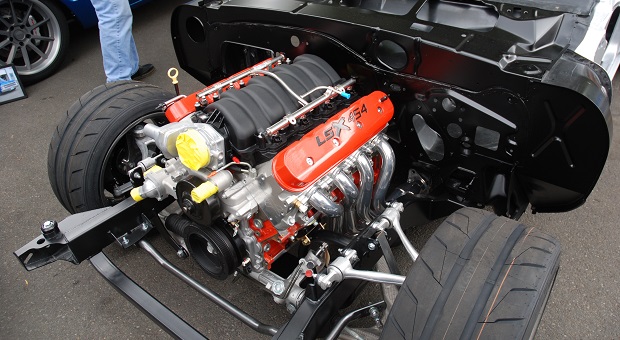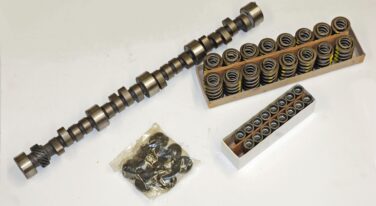
Hooker LS Swaps in '67-69 Camaro & '68-72 Nova Part 2
Click Here to Begin Slideshow
In the initial installment of this series, we looked at the bones of an LS swap – motor mounts and transmission cross members. If you recall, we noted that the Hooker Headers swap parts were a chunk of the swap process, but not all of it. Hooker’s parent company, Holley, has engineered a cast aluminum oil pan designed specifically for this application and others where clearance issues exist at the front half of the oil pan. First generation Camaros and third generation Novas immediately come to mind, but the pan is also applicable to various GM A-bodies (Chevelles, Cutlass’s, GTO’s, etc.) along with later model G-bodies (Buick Regals, Monte Carlos, etc.).
The pan engineered for our target Camaro-Nova application is Holley part number 302-2. It can be used for LS engines with strokes up to, but no greater than, 3.625-inches. This means the pan can be used on many popular LS swap engines (for example, the LS3). It cannot be used on the long stroke LS7 or Chevy’s LSX454.
When the Holley engineering folks sat down to design the pan, they had several parameters in mind. First, the pan had to provide OEM fitment. That meant that it had to fit as well as a stock part, and at the same time, it had to incorporate the factory oil filter mounting points, maintain a provision for an oil cooler, maintain OEM bell housing attachments, provide for OEM production line style gaskets and sealing and, finally, provide for proper structural rigidity and maintain the factory noise, vibration and harmonics suppression qualities of a stock pan. Whew! As you can see, it was a pretty tall order.
That clean sheet of paper design resulted in a traditional high quality casting with machined mating surfaces. When the pan was engineered, they kept in mind the fact that Camaros and Novas are rear-steer cars (the steering linkage is behind the engine cross member). The total oil sump capacity of the pan is 5.7 quarts and, with the stock filter in place, 6.2 quarts. Holley’s oil pan kit includes a sump baffle, an OEM style pick-up tube, a sump plug, an oil filter adapter “stud”, an oil passage cover and various hardware components. The design requires the use of an LS3 dipstick (GM P/N 12634547) along with a dipstick tube (GM P/N 12625031). Holley advises that some LS engine applications have a plug installed in the block dipstick hole location. This plug must be removed before the oil pan is installed on the engine to allow the installation of the proper dipstick tube.
Holley’s 302-2 oil pan is designed to accept a GM LS F-Body windage tray (GM P/N 12558253). Holley notes that a modification to the windage tray is required to provide clearance for the pick-up tube. The instruction sheet provided with the pan includes a template for making this cut. In addition, a full-length windage tray may be used if the front quarter of the tray is removed.
When installing the pan, keep in mind the oil pan on LS engines is a structural member. Holley adds this technical info: “The alignment of the pan is critical to provide the proper mounting points for the transmission bell housing. The rear of the oil pan must never protrude from the rear of the block. The rear of the block and oil pan are to be flush.
“It is advisable to test-fit the oil pan to the engine before installation to ensure that the crankshaft and connecting rods clear the windage tray, oil pump pick-up screen, and the oil pan, making a full revolution of the rotating assembly by hand.
It is advisable to mock up the engine and oil pan in the intended vehicle to ensure there is no contact of the pan to the frame or cross members.”
Finally, you’ll need a few additional items when installing the pan. They include an Oil Pan Gasket (GM12612350), a tube of high quality RTV sealant and an oil filter (AC Delco® PF48 or equivalent).
We’re not done yet. Next issue, we’ll examine headers and exhaust system parts. All of the exhaust components have been engineered specifically for the Camaro and Nova applications. The week after we'll conclude the series by
going over the accessory drive system. Watch for it.
In the initial installment of this series, we looked at the bones of an LS swap – motor mounts and transmission cross members. If you recall, we noted that the Hooker Headers swap parts were a chunk of the swap process, but not all of it. Hooker’s parent company, Holley, has engineered a cast aluminum oil pan designed specifically for this application and others where clearance issues exist at the front half of the oil pan. First generation Camaros and third generation Novas immediately come to mind, but the pan is also applicable to various GM A-bodies (Chevelles, Cutlass’s, GTO’s, etc.) along with later model G-bodies (Buick Regals, Monte Carlos, etc.).
The pan engineered for our target Camaro-Nova application is Holley part number 302-2. It can be used for LS engines with strokes up to, but no greater than, 3.625-inches. This means the pan can be used on many popular LS swap engines (for example, the LS3). It cannot be used on the long stroke LS7 or Chevy’s LSX454.
When the Holley engineering folks sat down to design the pan, they had several parameters in mind. First, the pan had to provide OEM fitment. That meant that it had to fit as well as a stock part, and at the same time, it had to incorporate the factory oil filter mounting points, maintain a provision for an oil cooler, maintain OEM bell housing attachments, provide for OEM production line style gaskets and sealing and, finally, provide for proper structural rigidity and maintain the factory noise, vibration and harmonics suppression qualities of a stock pan. Whew! As you can see, it was a pretty tall order.
That clean sheet of paper design resulted in a traditional high quality casting with machined mating surfaces. When the pan was engineered, they kept in mind the fact that Camaros and Novas are rear-steer cars (the steering linkage is behind the engine cross member). The total oil sump capacity of the pan is 5.7 quarts and, with the stock filter in place, 6.2 quarts. Holley’s oil pan kit includes a sump baffle, an OEM style pick-up tube, a sump plug, an oil filter adapter “stud”, an oil passage cover and various hardware components. The design requires the use of an LS3 dipstick (GM P/N 12634547) along with a dipstick tube (GM P/N 12625031). Holley advises that some LS engine applications have a plug installed in the block dipstick hole location. This plug must be removed before the oil pan is installed on the engine to allow the installation of the proper dipstick tube.
Holley’s 302-2 oil pan is designed to accept a GM LS F-Body windage tray (GM P/N 12558253). Holley notes that a modification to the windage tray is required to provide clearance for the pick-up tube. The instruction sheet provided with the pan includes a template for making this cut. In addition, a full-length windage tray may be used if the front quarter of the tray is removed.
When installing the pan, keep in mind the oil pan on LS engines is a structural member. Holley adds this technical info: “The alignment of the pan is critical to provide the proper mounting points for the transmission bell housing. The rear of the oil pan must never protrude from the rear of the block. The rear of the block and oil pan are to be flush.
“It is advisable to test-fit the oil pan to the engine before installation to ensure that the crankshaft and connecting rods clear the windage tray, oil pump pick-up screen, and the oil pan, making a full revolution of the rotating assembly by hand.
It is advisable to mock up the engine and oil pan in the intended vehicle to ensure there is no contact of the pan to the frame or cross members.”
Finally, you’ll need a few additional items when installing the pan. They include an Oil Pan Gasket (GM12612350), a tube of high quality RTV sealant and an oil filter (AC Delco® PF48 or equivalent).
We’re not done yet. Next issue, we’ll examine headers and exhaust system parts. All of the exhaust components have been engineered specifically for the Camaro and Nova applications. The week after we'll conclude the series by
going over the accessory drive system. Watch for it.


![[Gallery] Show us Your Mustang! Celebrating 60 Years of Mustang](https://www.racingjunk.com/news/wp-content/uploads/2024/04/Al-Liebmann-376x206.webp)

![[Gallery] Okolona Street Rods Kentuckiana V Foundation Car Show](https://www.racingjunk.com/news/wp-content/uploads/2022/04/IMG_0774-e1650040587750-376x206.jpg)
![[Gallery] Road Rats Car Show](https://www.racingjunk.com/news/wp-content/uploads/2022/05/2A-e1651770667920-376x206.jpg)
Leave a Reply